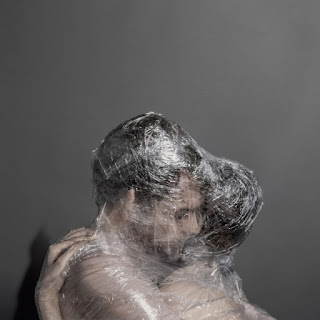Critical and Contextual Analysis Essay -
This is a photograph by a fine art documentary photographer, named Mendel Grossman, and is part of the 1939 series telling the story of the Lodz ghetto. Grossman was a Jewish man evicted from his home and then relocated to the Polish ghetto where the persecution of fellow Jews was prominent under the Nazi regime. His photographic series was a document of a temporal setting which many people neglected from their memory and very few images were captured or even survived the war; these images are a staple of world history. Prior to these atrocities Grossman was a still-life photographer but the war changed his outlook and therefore, also, his style. The original idea for the project was an album for the "Jewish Organisation for the Protection of Children's Health" and both poetically and tragically put "the photographs got lost in the war, and at the same time so did their subjects, the Jewish child".

The studium of this photograph, as coined by Roland Barthes, is children at play but a closer examination of the image tells a deeper implicit story through the punctum. The important details of this photo are vital in providing the context and criticism of society that the photographer stood for. The setting of the factory tower in the left third of the image, the use of the baton and most importantly the Jewish police uniform worn by the young boy on the right serve as the connotative details. To further this, the tower stands powerful in the left as a constant reminder of the gas chambers and incineration processes of anti-Semitism employed by the Nazi's. Although, it could also be a focal point that instead expands upon the idea of factory work and the manual exploitation of marginally healthy Jewish men who would work until their death; in a sinister way there is a foreshadowing of the photographer's own death as a result of the death march he subsequently died during after being a slave to the system of oppression at a labour camp in Reich. Additionally, the semiotic symbolic sign of the baton constantly reminds the audience of the brutality of the spatial context; the Jewish ghetto was a place of execution by hanging, beating by baton and death due to illness and starvation. The baton itself used to be a symbol of order and protection of the people by the police, but once adopted by the Jewish Police of the ghetto, who were awarded extra rations and privileges for betraying their own people, it became a tool for fear. Moreover, the young boy on the right of the image is captured wearing a child sized Jewish police issued outfit that signifies his position of power over the other child in the photograph, the arm band being the insignia of the Jewish police. This may link contextually to Grossman himself infiltrating the parties of the elites in the ghetto where he was appalled by the extravagant living that so starkly contrasted his own; the police were some of these privileged. Therefore, the use of the two children, one representing the elite oppressors and the other conveying the lower oppressed is a statement on the whole system of segregation not only of the Jews in the ghetto but also of the Jews from others in society who did not share their beliefs. Furthermore, the smile on the child’s face is a subject of interest. The smile itself is a punctum and could be interpreted either as sinister or as childhood naivety or innocence as the viewer does not know whether the children consider themselves at play or if they are recreating a scene of their environment. The inconography of this image provided a platform that fellow Jews could relate to which was important for Grossman as he distributed prints of his photographs to his peers keeping only the negatives for himself. These photographs serves almost as propaganda for the people against the people in power.
More simply, the stadium of this image, had all of the punctum been removed, could be a universal idea of children at play. The reprimanded positioning of the subjects in the photograph, one boy holding the power over the other, could have been less sinister and more in kinship to a game of cops and robbers or cowboys and Indians.
This image is extremely powerful and is one that needs to be appreciated for the cynical humour and critical perspectives of a dark time in history.
Post Research Notes -
How has your research informed your understanding of life in the Jewish ghetto?
My understanding of life in the Jewish ghetto of Poland has been extremely insightful. I had not previously known that the reach and power of the Nazi's allowed them to relocate Jewish families from Austria, Germany, Czechoslovakia and Luxembourg to Poland.
I was aware of many of the appalling standards of the ghetto's but the photographic evidence has made it much more potent to discuss and document.
Additionally, the personal story gives a power to the photographs which make them so much more emotional, sinister and a powerful reminder of a dark time in world history.
How does your research help you in recognising photography as a documentary tool?
Personally, being extremely interested in photojournalism I was aware of the power of photographs in the media as a documentary tool. A favourite photographer of mine is Don McCullin who uses his camera to document the flaws in the world society from war, famine and natural disasters.
Additionally, the power of a front page newspaper is so often dominated by a large image and smaller text; instances of horror such as war, terrorism and natural disaster are made potent by their photographs.







